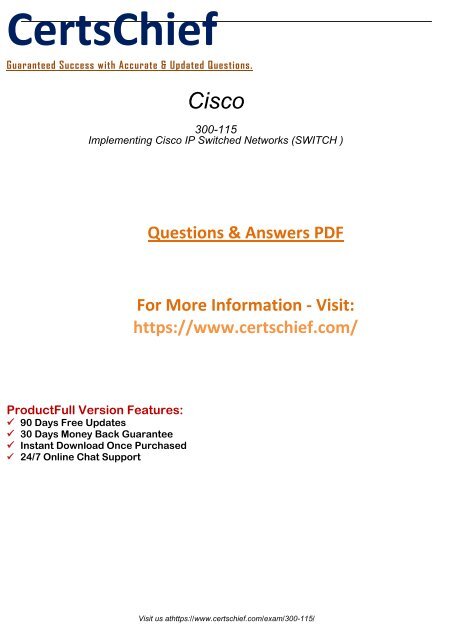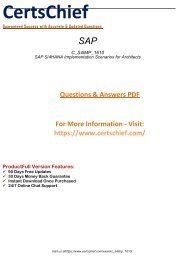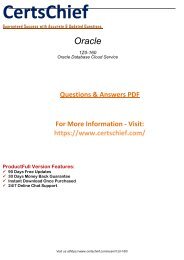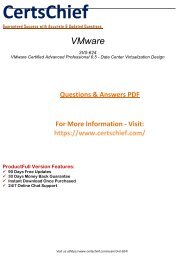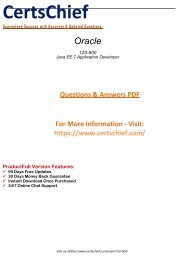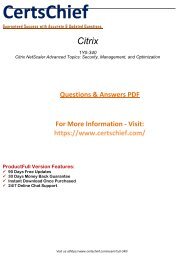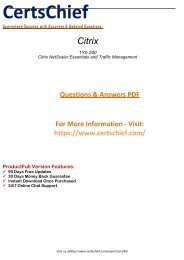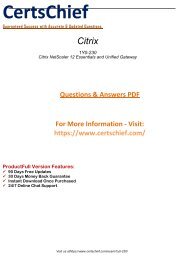300-115
Study units and arrangement materials gave by us to 300-115 Test are approved by the experts and industry specialists. You can without much of a stretch breeze through your accreditation test with our cerebrum dumps and PDF test questions. please use 20off2018 as discount voucher to avail 20% discount. For more information please visit here: https://www.certschief.com/exam/300-115/
Study units and arrangement materials gave by us to 300-115 Test are approved by the experts and industry specialists. You can without much of a stretch breeze through your accreditation test with our cerebrum dumps and PDF test questions. please use 20off2018 as discount voucher to avail 20% discount. For more information please visit here: https://www.certschief.com/exam/300-115/
You also want an ePaper? Increase the reach of your titles
YUMPU automatically turns print PDFs into web optimized ePapers that Google loves.
CertsChief<br />
Guaranteed Success with Accurate & Updated Questions.<br />
Cisco<br />
<strong>300</strong>-<strong>115</strong><br />
Implementing Cisco IP Switched Networks (SWITCH )<br />
Questions & Answers PDF<br />
For More Information - Visit:<br />
https://www.certschief.com/<br />
ProductFull Version Features:<br />
90 Days Free Updates<br />
30 Days Money Back Guarantee<br />
Instant Download Once Purchased<br />
24/7 Online Chat Support<br />
Visit us athttps://www.certschief.com/exam/<strong>300</strong>-<strong>115</strong>/
Question: 1<br />
What is the maximum number of switches that can be stacked using Cisco StackWise?<br />
A. 4<br />
B. 5<br />
C. 8<br />
D. 9<br />
E. 10<br />
F. 13<br />
Question: 2<br />
Answer: D<br />
A network engineer wants to add a new switch to an existing switch stack. Which configuration must be<br />
added to the new switch before it can be added to the switch stack?<br />
A. No configuration must be added.<br />
B. stack ID<br />
C. IP address<br />
D. VLAN information<br />
E. VTP information<br />
Question: 3<br />
Answer: A<br />
What percentage of bandwidth is reduced when a stack cable is broken?<br />
A. 0<br />
B. 25<br />
C. 50<br />
D. 75<br />
E. 100<br />
Question: 4<br />
Answer: C<br />
Visit us athttps://www.certschief.com/exam/<strong>300</strong>-<strong>115</strong>/
Refer to the exhibit.<br />
Which set of configurations will result in all ports on both switches successfully bundling into an<br />
EtherChannel?<br />
A. switch1<br />
channel-group 1 mode active<br />
switch2<br />
channel-group 1 mode auto<br />
B. switch1<br />
channel-group 1 mode desirable<br />
switch2<br />
channel-group 1 mode passive<br />
C. switch1<br />
channel-group 1 mode on<br />
switch2<br />
channel-group 1 mode auto<br />
D. switch1<br />
channel-group 1 mode desirable<br />
switch2<br />
channel-group 1 mode auto<br />
Question: 5<br />
Answer: D<br />
Refer to the exhibit.<br />
Visit us athttps://www.certschief.com/exam/<strong>300</strong>-<strong>115</strong>/
How can the traffic that is mirrored out the GigabitEthernet0/48 port be limited to only traffic that is<br />
received or transmitted in VLAN 10 on the GigabitEthernet0/1 port?<br />
A. Change the configuration for GigabitEthernet0/48 so that it is a member of VLAN 10.<br />
B. Add an access list to GigabitEthernet0/48 to filter out traffic that is not in VLAN 10.<br />
C. Apply the monitor session filter globally to allow only traffic from VLAN 10.<br />
D. Change the monitor session source to VLAN 10 instead of the physical interface.<br />
Question: 6<br />
Answer: C<br />
Refer to the exhibit.<br />
A network engineer wants to analyze all incoming and outgoing packets for an interface that is<br />
connected to an access switch. Which three items must be configured to mirror traffic to a packet sniffer<br />
that is connected to the distribution switch? (Choose three.)<br />
A. A monitor session on the distribution switch with a physical interface as the source and the remote<br />
SPAN VLAN as the destination<br />
B. A remote SPAN VLAN on the distribution and access layer switch<br />
C. A monitor session on the access switch with a physical interface source and the remote SPAN VLAN as<br />
the destination<br />
D. A monitor session on the distribution switch with a remote SPAN VLAN as the source and physical<br />
interface as the destination<br />
Visit us athttps://www.certschief.com/exam/<strong>300</strong>-<strong>115</strong>/
E. A monitor session on the access switch with a remote SPAN VLAN source and the physical interface as<br />
the destination<br />
F. A monitor session on the distribution switch with a physical interface as the source and a physical<br />
interface as the destination<br />
Question: 7<br />
Answer: B, C, D<br />
After an EtherChannel is configured between two Cisco switches, interface port channel 1 is in the<br />
down/down state. Switch A is configured with channel-group 1 mode active, while Switch B is<br />
configured with channel-group 1 mode desirable. Why is the EtherChannel bundle not working?<br />
A. The switches are using mismatched EtherChannel negotiation modes.<br />
B. The switch ports are not configured in trunking mode.<br />
C. LACP priority must be configured on both switches.<br />
D. The channel group identifier must be different for Switch A and Switch B.<br />
Question: 8<br />
Answer: A<br />
An EtherChannel bundle has been established between a Cisco switch and a corporate web server. The<br />
network administrator noticed that only one of the EtherChannel links is being utilized to reach the web<br />
server. What should be done on the Cisco switch to allow for better EtherChannel utilization to the<br />
corporate web server?<br />
A. Enable Cisco Express Forwarding to allow for more effective traffic sharing over the EtherChannel<br />
bundle.<br />
B. Adjust the EtherChannel load-balancing method based on destination IP addresses.<br />
C. Disable spanning tree on all interfaces that are participating in the EtherChannel bundle.<br />
D. Use link-state tracking to allow for improved load balancing of traffic upon link failure to the server.<br />
E. Adjust the EtherChannel load-balancing method based on source IP addresses.<br />
Question: 9<br />
Answer: E<br />
Interface FastEthernet0/1 is configured as a trunk interface that allows all VLANs. This command is<br />
configured globally:<br />
monitor session 2 filter vlan 1 - 8, 39, 52<br />
What is the result of the implemented command?<br />
Visit us athttps://www.certschief.com/exam/<strong>300</strong>-<strong>115</strong>/
A. All VLAN traffic is sent to the SPAN destination interface.<br />
B. Traffic from VLAN 4 is not sent to the SPAN destination interface.<br />
C. Filtering a trunked SPAN port effectively disables SPAN operations for all VLANs.<br />
D. The trunk's native VLAN must be changed to something other than VLAN 1.<br />
E. Traffic from VLANs 1 to 8, 39, and 52 is replicated to the SPAN destination port.<br />
Question: 10<br />
Answer: E<br />
A network engineer notices inconsistent Cisco Discovery Protocol neighbors according to the diagram<br />
that is provided. The engineer notices only a single neighbor that uses Cisco Discovery Protocol, but it<br />
has several routing neighbor relationships. What would cause the output to show only the single<br />
neighbor?<br />
A. The routers are connected via a Layer 2 switch.<br />
B. IP routing is disabled on neighboring devices.<br />
C. Cisco Express Forwarding is enabled locally.<br />
D. Cisco Discovery Protocol advertisements are inconsistent between the local and remote devices.<br />
Question: 11<br />
Answer: A<br />
After the implementation of several different types of switches from different vendors, a network<br />
engineer notices that directly connected devices that use Cisco Discovery Protocol are not visible. Which<br />
vendor-neutral protocol could be used to resolve this issue?<br />
A. Local Area Mobility<br />
B. Link Layer Discovery Protocol<br />
C. NetFlow<br />
D. Directed Response Protocol<br />
Question: 12<br />
Answer: B<br />
Several new switches have been added to the existing network as VTP clients. All of the new switches<br />
have been configured with the same VTP domain, password, and version. However, VLANs are not<br />
passing from the VTP server (existing network) to the VTP clients. What must be done to fix this?<br />
Visit us athttps://www.certschief.com/exam/<strong>300</strong>-<strong>115</strong>/
A. Remove the VTP domain name from all switches with "null" and then replace it with the new domain<br />
name.<br />
B. Configure a different native VLAN on all new switches that are configured as VTP clients.<br />
C. Provision one of the new switches to be the VTP server and duplicate information from the existing<br />
network.<br />
D. Ensure that all switch interconnects are configured as trunks to allow VTP information to be<br />
transferred.<br />
Question: 13<br />
Answer: D<br />
After implementing VTP, the extended VLANs are not being propagated to other VTP switches. What<br />
should be configured for extended VLANs?<br />
A. VTP does not support extended VLANs and should be manually added to all switches.<br />
B. Enable VTP version 3, which supports extended VLAN propagation.<br />
C. VTP authentication is required when using extended VLANs because of their ability to cause network<br />
instability.<br />
D. Ensure that all switches run the same Cisco IOS version. Extended VLANs will not propagate to<br />
different IOS versions when extended VLANs are in use.<br />
Question: 14<br />
Answer: B<br />
Refer to the exhibit.<br />
Switch A, B, and C are trunked together and have been properly configured for VTP. Switch C receives<br />
VLAN information from the VTP server Switch A, but Switch B does not receive any VLAN information.<br />
What is the most probable cause of this behavior?<br />
A. Switch B is configured in transparent mode.<br />
B. Switch B is configured with an access port to Switch A, while Switch C is configured with a trunk port<br />
to Switch B.<br />
C. The VTP revision number of the Switch B is higher than that of Switch A.<br />
Visit us athttps://www.certschief.com/exam/<strong>300</strong>-<strong>115</strong>/
D. The trunk between Switch A and Switch B is misconfigured.<br />
Answer: A<br />
Question: 15<br />
Refer to the exhibit.<br />
Switch A, B, and C are trunked together and have been properly configured for VTP. Switch B has all<br />
VLANs, but Switch C is not receiving traffic from certain VLANs. What would cause this issue?<br />
A. A VTP authentication mismatch occurred between Switch A and Switch B.<br />
B. The VTP revision number of Switch B is higher than that of Switch A.<br />
C. VTP pruning is configured globally on all switches and it removed VLANs from the trunk interface that<br />
is connected to Switch C.<br />
D. The trunk between Switch A and Switch B is misconfigured.<br />
Question: 16<br />
Answer: C<br />
After the recent upgrade of the switching infrastructure, the network engineer notices that the port<br />
roles that were once "blocking" are now defined as "alternate" and "backup." What is the reason for this<br />
change?<br />
A. The new switches are using RSTP instead of legacy IEEE 802.1D STP.<br />
B. IEEE 802.1D STP and PortFast have been configured by default on all newly implemented Cisco<br />
Catalyst switches.<br />
C. The administrator has defined the switch as the root in the STP domain.<br />
D. The port roles have been adjusted based on the interface bandwidth and timers of the new Cisco<br />
Catalyst switches.<br />
Answer: A<br />
Visit us athttps://www.certschief.com/exam/<strong>300</strong>-<strong>115</strong>/
Question: 17<br />
An administrator recently configured all ports for rapid transition using PortFast. After testing, it has<br />
been determined that several ports are not transitioning as they should. What is the reason for this?<br />
A. RSTP has been enabled per interface and not globally.<br />
B. The STP root bridge selection is forcing key ports to remain in non-rapid transitioning mode.<br />
C. STP is unable to achieve rapid transition for trunk links.<br />
D. The switch does not have the processing power to ensure rapid transition for all ports.<br />
Question: 18<br />
Answer: C<br />
Which technique automatically limits VLAN traffic to only the switches that require it?<br />
A. access lists<br />
B. DTP in nonegotiate<br />
C. VTP pruning<br />
D. PBR<br />
Question: 19<br />
Answer: C<br />
What effect does the mac address-table aging-time 180 command have on the MAC address-table?<br />
A. This is how long a dynamic MAC address will remain in the CAM table.<br />
B. The MAC address-table will be flushed every 3 minutes.<br />
C. The default timeout period will be 360 seconds.<br />
D. ARP requests will be processed less frequently by the switch.<br />
E. The MAC address-table will hold addresses 180 seconds longer than the default of 10 minutes.<br />
Question: 20<br />
Answer: A<br />
While working in the core network building, a technician accidently bumps the fiber connection<br />
between two core switches and damages one of the pairs of fiber. As designed, the link was placed into<br />
Visit us athttps://www.certschief.com/exam/<strong>300</strong>-<strong>115</strong>/
a non-forwarding state due to a fault with UDLD. After the damaged cable was replaced, the link did not<br />
recover. What solution allows the network switch to automatically recover from such an issue?<br />
A. macros<br />
B. errdisable autorecovery<br />
C. IP Event Dampening<br />
D. command aliases<br />
E. Bidirectional Forwarding Detection<br />
Question: 21<br />
Answer: B<br />
A network engineer deployed a switch that operates the LAN base feature set and decides to use the<br />
SDM VLAN template. The SDM template is causing the CPU of the switch to spike during peak working<br />
hours. What is the root cause of this issue?<br />
A. The VLAN receives additional frames from neighboring switches.<br />
B. The SDM VLAN template causes the MAC address-table to overflow.<br />
C. The VLAN template disables routing in hardware.<br />
D. The switch needs to be rebooted before the SDM template takes effect.<br />
Question: 22<br />
Answer: C<br />
An access switch has been configured with an EtherChannel port. After configuring SPAN to monitor this<br />
port, the network administrator notices that not all traffic is being replicated to the management server.<br />
What is a cause for this issue?<br />
A. VLAN filters are required to ensure traffic mirrors effectively.<br />
B. SPAN encapsulation replication must be enabled to capture EtherChannel destination traffic.<br />
C. The port channel can be used as a SPAN source, but not a destination.<br />
D. RSPAN must be used to capture EtherChannel bidirectional traffic.<br />
Question: 23<br />
Answer: C<br />
Refer to the exhibit.<br />
Visit us athttps://www.certschief.com/exam/<strong>300</strong>-<strong>115</strong>/
What is the result of the configuration?<br />
A. The EtherChannels would not form because the load-balancing method must match on the devices.<br />
B. The EtherChannels would form and function properly even though the load-balancing and<br />
EtherChannel modes do not match.<br />
C. The EtherChannels would form, but network loops would occur because the load-balancing methods<br />
do not match.<br />
D. The EtherChannels would form and both devices would use the dst-ip load-balancing method because<br />
Switch1 is configured with EtherChannel mode active.<br />
Answer: B<br />
Question: 24<br />
A network engineer tries to configure storm control on an EtherChannel bundle. What is the result of<br />
the configuration?<br />
A. The storm control settings will appear on the EtherChannel, but not on the associated physical<br />
ports.<br />
B. The configuration will be rejected because storm control is not supported for EtherChannel.<br />
C. The storm control configuration will be accepted, but will only be present on the physical<br />
interfaces.<br />
D. The settings will be applied to the EtherChannel bundle and all associated physical interfaces.<br />
Answer: D<br />
Visit us athttps://www.certschief.com/exam/<strong>300</strong>-<strong>115</strong>/
Question: 25<br />
What is the function of NSF?<br />
A. forward traffic simultaneously using both supervisors<br />
B. forward traffic based on Cisco Express Forwarding<br />
C. provide automatic failover to back up supervisor in VSS mode<br />
D. provide nonstop forwarding in the event of failure of one of the member supervisors<br />
Answer: D<br />
Visit us athttps://www.certschief.com/exam/<strong>300</strong>-<strong>115</strong>/
Powered by TCPDF (www.tcpdf.org)<br />
For More Information - Visit:<br />
https://www.certschief.com/<br />
20% Discount Coupon Code:<br />
20off2018<br />
Visit us athttps://www.certschief.com/exam/<strong>300</strong>-<strong>115</strong>/<br />
http://www.certschief.com/exam/0B0-104/<br />
Page | 1


